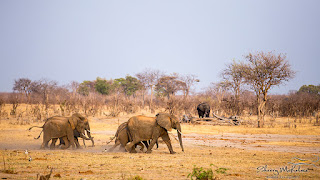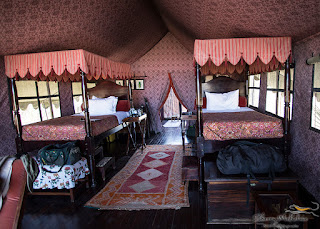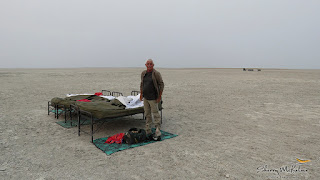Days 37 – 39 24th – 26th October
From
Vic Falls we flew south-east to Hwange National Park, landing at Hwange
National Park Airfield which is 10,000ft long and was extended as the emergency
landing strip for the space shuttle! Luckily we were able to land and stop
before the end of it! We then had a 2 ½ hour drive on what was left of a tarmac
road built in the 1950’s, winding through endless bare brown mopani-covered
flat terrain with a sighting of just one giraffe sitting under a tree….we began
to wonder what we had set ourselves up for!
And
then we reached the Camp Hwange concession – green-leaved trees suddenly
started appearing and our spirits rose.
Just around a corner, and there was a beautiful Sable Antelope – another
first for us – stunning beast!
The
camp itself is simple but tasteful, small, personal and comfortable, and the
food was delicious. Nothing was too much
trouble and there were no set meal times, so never any rush to get back from a
game drive when something interesting was going on.
In
front of the lodge is a large waterhole, and we were greeted by a family of
elephants drinking as we arrived. Hwange
was hot and dry and most of the waterholes had dried up. This one and a couple of others are kept wet
using a solar pump/ generator, pumping 6000 litres per hour 24/7, but even that
is not enough to serve the volume of traffic and we watched the water reduce
over the 3 days we spent there, the elephants really not helping themselves or
the other thirsty animals by destroying the solar panels on one pump, the pipe
connection to the hole in front of the lodge (on days 2 and 3) and the
electrics on another pump system!
A
constant stream of elephants came all through the afternoon and the majority of
our evening game drive was spent simply watching them splashing, playing, and
sucking up great trunkfuls of water. Several herds actually ran to the water
rather than strolling along, showing just how thirsty they were.
Next
they were joined by a lioness, who lapped and lapped to quench her thirst, then
settled down to watch the action as a huge herd of buffalo appeared through the
dust, along with roan antelope, zebra, impala, warthogs, grey-crowned cranes, and hundreds of doves and water birds.
It
was the most amazing spectacle – we had never seen ellies in these numbers
before – and the noise!! Rumbling, trumpeting, squealing, sploshing mud about, screaming
– we were quite speechless. We should
add that those noises continued constantly throughout the night – just 100
metres from our cabin!
That
evening at dinner we were visited by one buffalo followed by a large elephant,
who decided that the water in the bird bath next to the dining area had
better-tasting water and proceeded to suck it dry!
During
the next couple of days the sheer quantity of animals dwindled slightly, but
the waterhole was never without visitors, including groups of 4 – 6 Roan and
Sable Antelopes.
The
other waterholes also had large herds of both elephant and buffalo and a
wonderful variety of game – even the hippos had terrapins sitting on their
backs! Sunsets were spectacular.
At
breakfast one morning we watched as four very grumpy old buffalo took
exception to a pair of young male lions sitting by the waterhole and proceeded
to chase them off into the bush.
The
parks in Zimbabwe are known for offering Walking Safaris and we had a couple of
great bush walks (temp approx. 43 degrees!), tracking animals and learning
about the plants and the habitat from the incredibly knowledgeable Guides. On one occasion we stopped to study a
year-old skeleton of an elephant, learning all about how the skull is formed,
etc.
On
our final day, we were lucky enough to view 5 different cats. On our morning drive a leopard ran out in
front of us, then we watched lions sleeping under a bush. In the evening, we suddenly realised that a
cheetah was drinking at the waterhole.
As we followed her a little way into the bush, we first saw an African
Wild Cat (from whom all cats are descended) and then a beautiful Serval, who
was incredibly calm in our presence and actually made use of our spotlight to
feed on the crickets that were attracted to it!
Unbelievable! As we headed back to camp we also saw little bushbabies in
the trees.
Our
three days there seemed to disappear in the blink of an eye, and we headed back
to the airstrip wondering how on earth we would be able to write this blog and
convey the wonder of this remarkable place.
So…
on to the October dry season in Mana Pools National Park with both of us a
little concerned as to how we will cope in 40+ degrees of heat!










































































